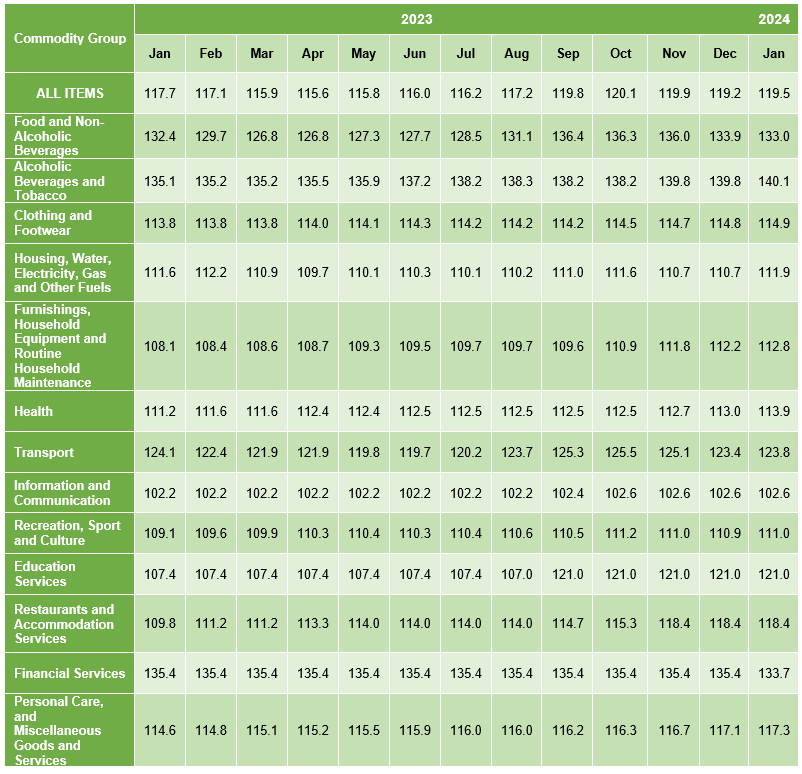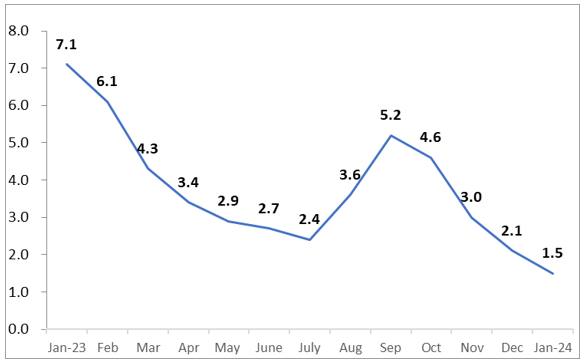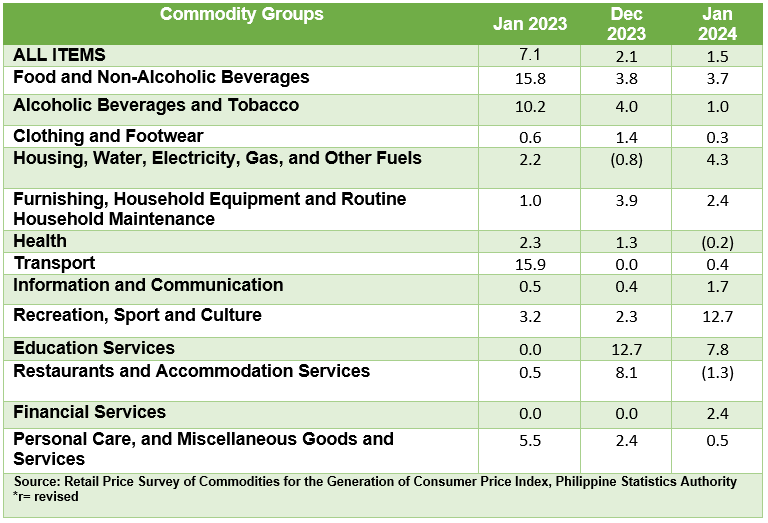Consumer Price Index
Consumer Price Index (CPI) is the general measure of the change in the average retail prices of a market basket or collection of goods and services commonly purchased by the average Filipino household.
The CPI of the City of Baguio in January was 119.5. Comparing to December 2023, index for the city increased by 0.3 point.
Table 1. Consumer Price Index for All Income Households in Baguio City,
Region and Country:
December 2022 and 2023, January 2023 and 2024
(2018=100)

Table 2. Consumer Price Index for All Income Household in Baguio City
by Commodity Group: January 2023- January 2024
(2018=100)

CPI by Commodity Groups
• Among the commodity groups, Alcoholic Beverages and Tobacco remained the highest CPI at 140.1 index points, increased by 0.3 index points from the previous month.
• Financial Services had the second highest CPI at 133.7 index points, decreased by 1.7 points.
• Food and Non-Alcoholic Beverages had the third highest CPI among the commodity groups in the city at 133.0 index points, decreased by 0.9 index points.
• Meanwhile, Information and Communication remained the lowest among the commodity groups at the city level with 102.6 index points.
Inflation Rate
Inflation is a rise in the general level of prices of goods and services in an economy over a period of time. When the general price level rises, each unit of currency buys fewer goods and services. A chief measure of price inflation is the inflation rate, the annualized percentage change in CPI over time.
Figure 1. Inflation Rates in Baguio City, All Items
(2018=100)

Source: Retail Price Survey of Commodities for the Generation of Consumer Price Index, Philippine Statistics Authority
Table 3. Year-on-Year Inflation Rates in Baguio City
By Commodity Groups
In percent
(2018=100)

Following the trend of the inflation at the national and regional level, inflation in Baguio City further decreased to 1.5 percent in January 2024, from 2.1 percent in December 2023. In January 2023, inflation was at 7.1 percent. The main driver in the downtrend of inflation in January 2024 was food and non-alcoholic beverages at 0.5 percent, from 3.8 percent in December 2023. This was followed by transport at -0.2 percent, from 0.0 percent, and clothing and footwear at 1.0 percent, from the 1.4 percent in the previous month. Also contributed to the downtrend are the following:
a. Alcoholic beverages and tobacco, 3.7 percent from 4.0 percent;
b. Recreation, sport and culture, 1.7 percent from 2.3 percent;
c. Restaurants and accommodation services, 7.8 percent from 8.1 percent; and
d. Financial services, -1.3 percent from 0.0 percent.
On the contrary, increases were observed in the indices of the following:
a. Housing, water, electricity, gas and other fuels, 0.3 percent from -0.8 percent;
b. Furnishing, household equipment and routine household maintenance, 4.3 percent from 3.9 percent;
c. Health, 2.4 percent from 1.3 percent.
Meanwhile, the rest of the commodity groups had retained their inflation rates for this month.
Food inflation at the city level further decreased to 0.3 percent in January 2024, from 3.9 percent in December 2023. In January 2023, food inflation stood at 16.6 percent.
The lower food inflation was mainly brought about by vegetables, tubers, plantains, cooking bananas and pulses at -26.1 percent this month from the -10.5 percent in December 2023. It was followed by fish and other seafood at 4.6 percent from 8.0 percent, and milk, other dairy products and eggs at 6.9 percent from 9.7 percent of the previous month. Decreases were also observed for the following:
a. Cereal and cereal products, 12.8 percent from 12.9 percent;
b. Meat and other parts of slaughtered land animals, 0.2 percent from 0.4 percent; and
c. Oils and fats, -1.6 percent from -1.3 percent.
Purchasing Power of the Peso (PPP)
Purchasing Power of Peso is a measure of the real value of peso in a given period relative to the base year. The nearer the base year to the current period, the higher the value of the peso derived. As the period goes farther from the base year, the value of peso diminishes as this is “eaten up” by the inflationary factors.
The value of 1 peso in the city remained at 84 centavos in January 2024. This can be translated that one peso in 2018 was worth 84 centavos in January 2024.
(SGD)
IMELDA L. BUYUCCAN
Chief Statistical Specialist
/SMBP
Technical Notes
Consumer Price Index (CPI) is a general measure of the change in the average retail prices of a market basket or collection of goods and services commonly purchased by the average Filipino household.
Inflation Rate (IR) is the rate of change in the average price level between two periods (year-on year/month-on-month as measured by the CPI).
Purchasing Power of the Peso (PPP) measures how much the peso in the reference year is worth in another year.
Base Year (BY) is the reference point of the index number series, at which the index number is set to 100. It is the reference point of the index number series.
The CPI is now rebased from base year 2012 to base year 2018. The rebasing of the CPI is done periodically by the PSA:
1) to ensure that the CPI market basket continues to capture goods and services commonly purchased by households over time;
2) to update expenditure patterns of households; and
3) to synchronize its base year with 2018 base year of the Gross Domestic Product and other indices produced by PSA such as Producer Price Index (PPI) for Agriculture; PPI for Manufacturing; and Value of Production Index (VaPI), Volume of Production Index (VoPI), and Value of Net Sales Index (VaNSI) for Manufacturing.
The rebasing of the CPI is also in accordance with the PSA Board Resolution No.1 Series 2017-146 which approves the synchronized rebasing of the price indices to base year 2006 and every six (6) years thereafter.
Market Basket (MB) is a sample of goods and services used to represent all goods and services produced or bought.

